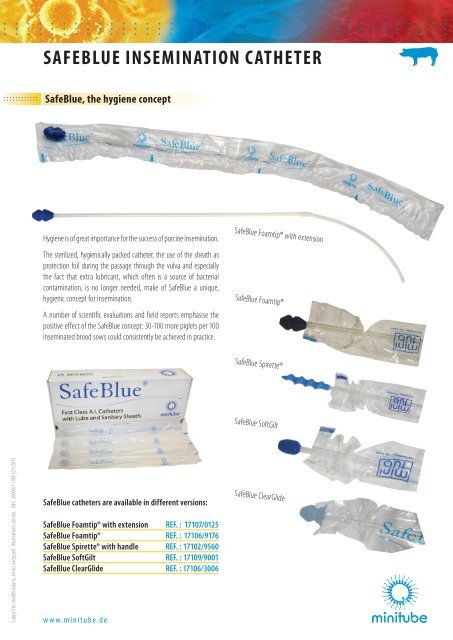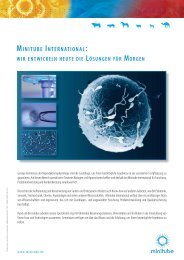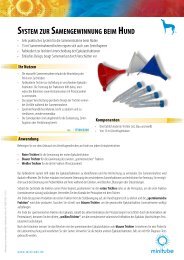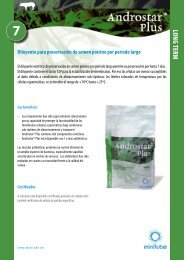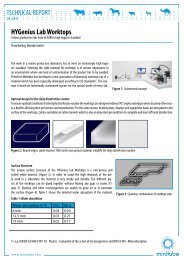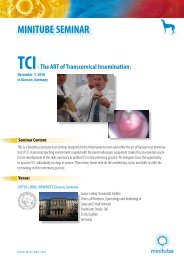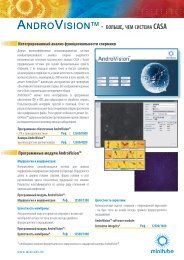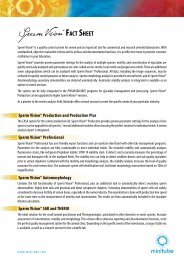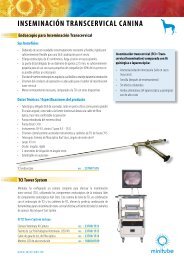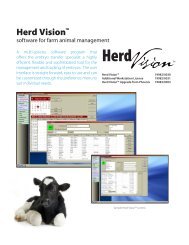Safeblue InSemInatIon Catheter
Safeblue InSemInatIon Catheter
Safeblue InSemInatIon Catheter
You also want an ePaper? Increase the reach of your titles
YUMPU automatically turns print PDFs into web optimized ePapers that Google loves.
::::::::::::<br />
Subject to modifications, errors excepted. Illustrations similar. REF.: 30000/11184 | 01/2013<br />
<strong>Safeblue</strong> <strong>InSemInatIon</strong> <strong>Catheter</strong><br />
<strong>Safeblue</strong>, the hygiene concept<br />
Hygiene is of great importance for the success of porcine insemination.<br />
The sterilized, hygienically packed catheter, the use of the sheath as<br />
protection foil during the passage through the vulva and especially<br />
the fact that extra lubricant, which often is a source of bacterial<br />
contamination, is no longer needed, make of SafeBlue a unique,<br />
hygienic concept for insemination.<br />
A number of scientific evaluations and field reports emphasise the<br />
positive effect of the SafeBlue concept: 30-100 more piglets per 100<br />
inseminated brood sows could consistently be achieved in practice.<br />
SafeBlue catheters are available in different versions:<br />
SafeBlue Foamtip® with extension REF. : 17107/0125<br />
SafeBlue Foamtip® REF. : 17106/9176<br />
SafeBlue Spirette® with handle REF. : 17102/9560<br />
SafeBlue SoftGilt REF. : 17109/9001<br />
SafeBlue ClearGlide REF. : 17106/3006<br />
www.minitube.de<br />
SafeBlue Foamtip® with extension<br />
SafeBlue Foamtip®<br />
SafeBlue Spirette®<br />
SafeBlue SoftGilt<br />
SafeBlue ClearGlide
:::::::::::: Your benefits<br />
Very clean insemination with little efforts.<br />
• The sterilised catheter remains clean and free of contaminants<br />
during storage until insemination.<br />
• Because of the protective sanitary sheath, the catheter remains<br />
clean during the insertion in the vulva after which the catheter<br />
tip is pushed through the sheath.<br />
• No more fumbling with lubricants<br />
• Improved pregnancy rates and litter numbers<br />
:::::::::::: application<br />
• Clean the outside of the sow’s vulva with a dry paper towel.<br />
• Introduce the catheter with the sanitary sheath 5-10 cm; then<br />
push the catheter tip through the sheath<br />
• Pull the sheath backwards<br />
• Screw off the tip of the QuickTip tube and lock it in the catheter<br />
shaft with a quarter of a turn. Start the A.I.<br />
:::::::::::: literature<br />
Hoy, S., De Alba, C. (2005): Minimizing the risk of contamination<br />
during artificial insemination improves reproductive results in sows.<br />
Reproduction in Domestic Animals Vol. 40, No. 4, pp 390.<br />
Hoy, S., De Alba, C. (2005): Improvement in breeding results by<br />
technician skills and hygiene during routine artificial insemination<br />
of sows. Proceedings of the 7th International Conference on Pig Reproduction,<br />
Kerkrade, The Netherlands, pp 134.<br />
Better hygiene during AI improves fertility (2004). International Pig<br />
Topics, Volume 19, No. 6.<br />
Heinze, A. (2006): „Mehr Aufmerksamkeit für Besamungshygiene.“<br />
Thüringer Landesanstalt für Landwirtschaft<br />
Hoy, S. (2005a): Die „sterile“ Besamung – Eingeschweißter Besamungskatheter<br />
erhöht die Abferkelrate. BLW 2.<br />
www.minitube.de<br />
Improved pregnancy rates<br />
through artificial insemination<br />
with <strong>Safeblue</strong>-catheters<br />
91,8 %<br />
1031<br />
Piglets<br />
80,6 %<br />
890<br />
Piglets<br />
141 more piglets per 100 inseminated sows<br />
-> 1.41 more piglets per sow (+15,8 %)<br />
In the field trial of Hoy et al. (2005a), 141 more piglets per<br />
100 sows were achieved by using SafeBlue, compared to a<br />
conventional insemination catheter.<br />
Hoy, S. (2005b): More piglets with a single wrapped sterilized catheter.<br />
Pig Process, Volume 21, No. 8.<br />
TA Temmen, F. (2003): Erfahrungsbericht zum Besamungskatheter<br />
“SafeBlue“. BES Golzow, Deutschland.<br />
Reicks DL (2003): Bacterial contamination and semen quality. Proc.<br />
Allen D. Leman Swine Conf., 169-170.<br />
Thompson, R. (2000): Transportation, cleaning and disinfection<br />
swine health fact sheet. Vol. 2, n°2, January, NPPC.<br />
De Winter PPJ, Verdonck, M., de Krief, A., Devriese LA, Haesebrouck<br />
(1992): Endometritis and vaginal discharge in the sow. Anim<br />
Reprod Sci; 28: 51-58.


